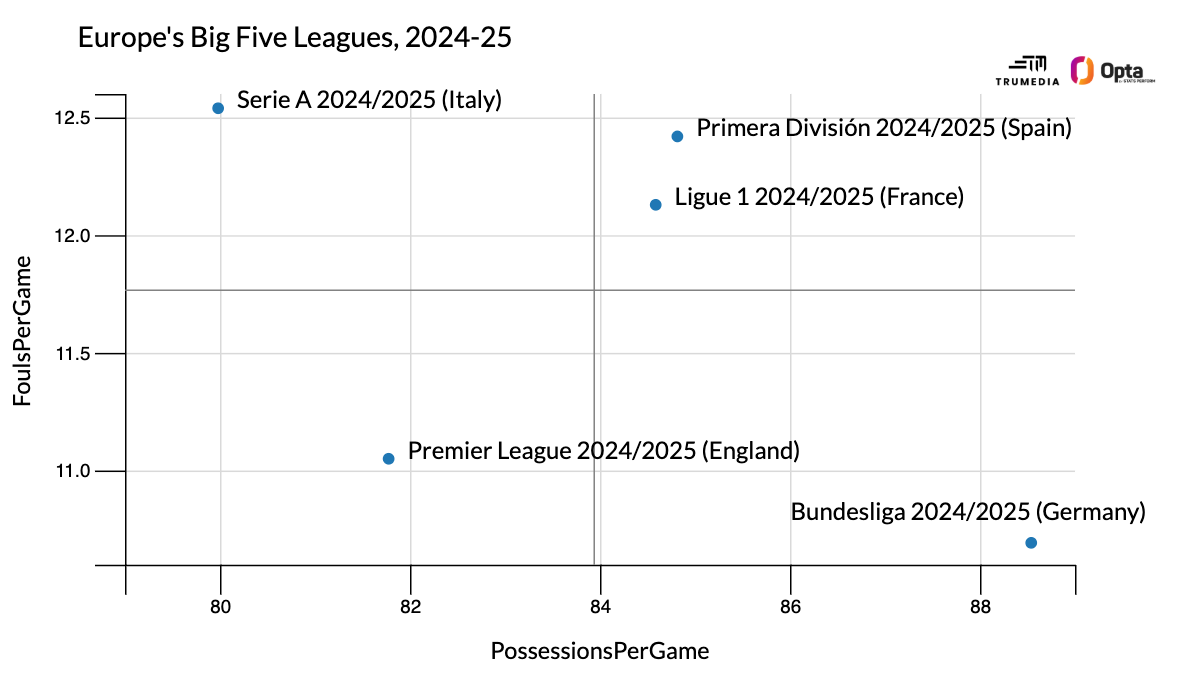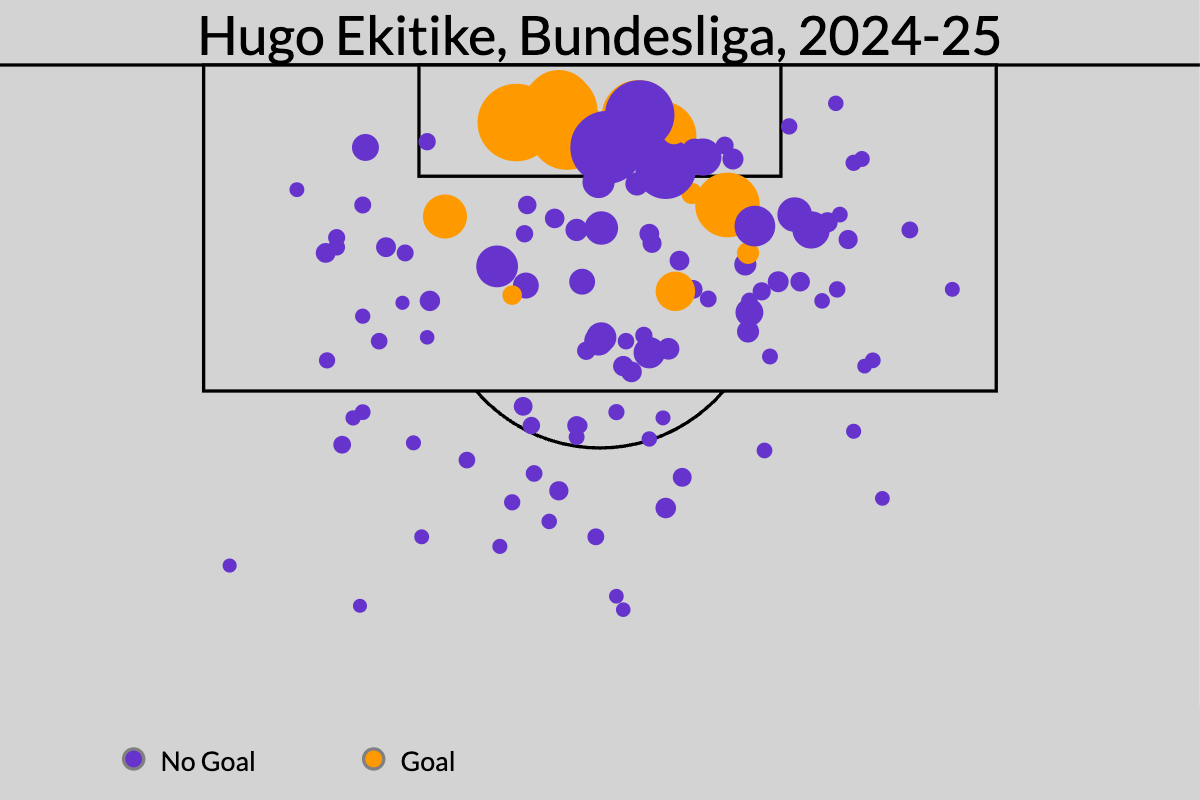Hugo Ekitike is going to be a superstar. Hugo Ekitike is going to be a bust.
Depending on how hard I squint, I can pretty easily convince myself that either of those things is true. The 23-year-old Frenchman is a transfer-scouting Rorschach test: How you view him says everything about how you view the sport.
More than any player I can remember, Ekitike somehow both reaffirms and rejects conventional wisdom and scouting biases. He’s a physical marvel with glaring physical weaknesses. He’s an analytics darling with massive analytical red flags. He’s a production machine without a track record of goals and assists. He’s a young prospect without enough experience. He has already done it in a top league; it just wasn’t the right top league.
More from Ryan O’Hanlon:
– The USMNT’s to-do list before 2026 World Cup
– Who should win the 2025 Ballon d’Or?
– Why Arsenal’s ‘win now’ approach might be a mistake
After a head-fake toward joining Newcastle, Ekitike is bound for Liverpool. While the defending Premier League champs navigate the transfer market better than everyone, they’re on the verge of signing a player who looks like a future world-class forward and a future what-were-they-thinking entry on a bottom-10 list — all at the same time.
Hugo Ekitike is everything that dumb clubs get wrong about transfers and everything that smart clubs get right.
Why he’s going to fail
In the NBA, they’re obsessed with unicorns to the point where it seems like having a horn sticking out of the center of your forehead is a prerequisite entering the draft.
The term was first used in 2016 by superstar Kevin Durant to describe New York Knicks draft pick Kristaps Porzingis. The 7-foot-3 Latvian prospect was able to protect the basket and shoot 3s. There hadn’t really been a player like this in NBA history. You mucked around in the paint or you shot 3s — but you never did both.
Nearly a decade later, every NBA team has at least one player who can guard the rim and score from range, while the best teams have multiple players who can do a bit of everything: gangly 6-foot-8 types who can dribble, create, shoot, defend, jump, park your car, sell popcorn, negotiate a favorable lease and soothe a crying child.
Soccer hasn’t entered its “unicorn” era yet — and may we all please recognize the irony before we get in too deep — but if we’re going to get there, we’ll be led into the new age by a 6-foot-3 French dude with the foot skills of Rafael Leão and the speed of Anthony Gordon. You don’t need to understand anything about soccer to understand that there’s something different about this guy:
And, well, of course scouts are going to love this guy; this is the guy scouts have always loved. He looks good in jeans. He’s so good on the ball. He’s way faster than anyone his size has any right to be. And perhaps most importantly, he’s projectable. Ekitike clearly isn’t the finished project, and there’s nothing that coaches love more than being able to “coach a guy up.” Imagine if you could add a little bite to this guy’s game? Sure, he’s only 170 pounds soaking wet, but just wait until your strength and conditioning staff gets a hold of him.
These, of course, are the questions that have historically led scouts and coaches astray. Instead of focusing on, you know, players who are good at the fundamentals of playing soccer and helping their teams win, teams get seduced by what athletic players might one day do if they somehow land on their optimal development path. Using data to assess players was supposed to help teams avoid these kinds of mistakes and create a much more comprehensive assessment of a player’s profile than the kind of biased, aesthetic-based judgments we all succumb to from simply watching tape.
Plus, there’s always less time for these players to develop than we think. Soccer players’ peak years occur much earlier — between 24 and 28, more precisely — than anyone would like to admit, and the players who get by on physical skills tend to decline much more quickly than their more-skilled peers.
Ektike is young by almost any definition — he just turned 23 last month — but he’s only a year away from his soccer-playing prime. There’s not a ton of time left for him to acquire new skills or strength. His new team will need him to start contributing almost right away, and while he did just contribute for Eintracht Frankfurt this past season, it was still only his first real season contributing at a professional level.
In 2024-25, Ekitike scored 14 non-penalty goals and added eight assists in 2,563 league minutes — good enough for 0.77 goals+assists per 90. Among players who featured in at least 2,000 Premier League minutes last season, only his future teammate Mohamed Salah and Newcastle’s Alexander Isak were more productive. But players can have career years at any moment. So if you’re signing Ekitike, you might be signing him on the back of an outlier season, but you won’t know because he has played only one real season.
Now, Ekitike had played nearly 3,000 minutes prior to this past season — first with Reims and then Paris Saint-Germain in Ligue 1, and then in 2023-24 with Frankfurt — and his production was almost exactly the same across that stretch as it was in 2024-25. But nearly half of those 63 appearances before last season came as a sub, and substitute attackers score and assist goals at much higher rates than starters do.
Beyond all of this, the biggest red flag is the environment in which he contributed to those 22 goals. The Bundesliga is just a different league than the Premier League, or any of the other Big Five leagues. Here’s how all five compare by the number of possessions each team averages per game and the number of fouls:

The ball is turned over way more often in the Bundesliga, so there are way more transitional moments and therefore way more space for attackers to run into. And while fouls aren’t a perfect proxy for the physicality of the league, there just is much less body-to-body contact in Germany because of how much more space there is on the field.
Ekitike’s slight frame rarely got tested last season. For this reason, on average, Bundesliga attackers tend to produce at a significantly lower level when they move to the Premier League. (Timo Werner, anyone?)
– Grading every major summer transfer
– Why Liverpool signed Ekitike, and what he brings to Premier League
But it’s not just that Ekitike is coming from the Bundesliga; it’s that he’s coming from Frankfurt in particular. In the five years from 2019 through 2024 — not counting Omar Marmoush’s move to Manchester City halfway through last season — the club transferred out the following attackers:
• Randal Kolo Muani: 24 years old, €95 million to PSG
• Luka Jovic: 21, €61m to Real Madrid
• Sébastien Haller: 25, €50m to West Ham
• Jesper Lindstrom: 23, €30m to Napoli
• André Silva: 25, €23m to RB Leipzig
That’s more than €250 million from five attackers who combined to produce one — one! — double-digit goal season for their new clubs. And of the five, three spent at least part of last season on loan, while the other two have long since departed the clubs that acquired them from Frankfurt.
Do you want to bet on the sixth time being the charm?
2:06
Will there be a four-way title race in the upcoming Premier League season?
Mark Ogden suggests the 2025-26 season could be the most competitive Premier League title race of all time.
Why he’s going to flourish
Even as expected goals have infected the internet and even begun to get the occasional not-totally-dismissive mention on mainstream television broadcasts, we’re still not close to reaching a point where the concept is understood properly, let alone employed in any strategic fashion.
Expected goals remains the most powerful predictive metric that we have, both at a team and individual level. It predicts future goals and wins better than any other single statistic, including past goals and past wins. Depending on your viewpoint, this either created new knowledge or confirmed previously existing knowledge of the sport: players score lots of goals because of the volume and quantity of the chances they get, not because of how good they are at converting their chances over the long haul.
The Stats Perform database has 512 goals for Lionel Messi for Barcelona, from 409.36 expected goals. The simple way to think about this is that only 20% of Messi’s goal scoring could be explained by his finishing skill — and he’s the greatest converter of shots to ever live. (Everyone else is going to be way below that 20% rate.)
The remaining 80% of his goal scoring was predicted by an algorithm that knew the location, body part, pass type and a handful of other shot characteristics, but had no clue where the shot ended up on the goal frame or who was even attempting the shot. For Cristiano Ronaldo at Real Madrid, the connection was even tighter: 394 goals from 343.82 xG.
Were you going to employ this information to gain an advantage on your competitors, you would be quicker to cut ties with players who had hot finishing seasons since you could be confident their goal scoring would regress, and their transfer values would never be higher. Equally, you would try to acquire players who had generated lots of expected goals, but failed to turn them into the requisite number of actual goals since they were likely to be undervalued.
Well, so far this summer, Manchester United have spent over €150 million on fees to acquire Matheus Cunha from Wolverhampton Wanderers and Bryan Mbeumo from Brentford. Mbeumo scored 7.7 goals more than expected this past season, while Cunha was 6.4 above his expected number. These were the first- and second-biggest gaps in the league. So if you were trying to predict which two Premier League players would experience the biggest drop-off in goals this season, you would put Mbeumo and Cunha right at the top of the list — and United have built their summer, and their short-term success, around acquiring both of them.
At the other end of the spectrum, Ekitike scored 14 non-penalty goals from 19.3 expected goals — the biggest underperformance of any player across Europe’s Big Five leagues:

And so, let’s flip this around: If you were trying to predict what player in Europe was going to experience the biggest increase in goal-scoring this season, Ektike would be at the top of the list. Only Salah and Isak were more productive per-minute than Ekitike this season — and he, really, was even better than that.
If we add his expected goals and expected goals assisted numbers together, Ekitike averaged 0.91 xG+xAG per 90 last season. The only players who played at least 2,000 minutes and were better across Europe’s top five leagues: PSG’s Ousmane Dembélé, PSG’s Bradley Barcola, and Barcelona’s Raphinha. The two players right behind Ekitike: Barcelona’s Robert Lewandowski and Salah.
But even that might be underselling Ekitike’s potential. Scoring goals and creating goals are the primary drivers of attacking value, but with center forwards, teams will often ignore the trade-offs that come with a lot of these players. While Kylian Mbappé and Erling Haaland are two of the best players in the world, I do think their limitations — Mbappe out of possession, Haaland in possession — make them slightly less valuable players than their top-line numbers suggest. And I think we’ve seen this in how both of their teams, on the whole, have been worse since they arrived at their new clubs despite each of them producing out-of-this-world individual numbers.
With Ekitike, though, there’s reason to believe these trade-offs might not exist. He’s an active presser for his position, he’s a fantastic passing outlet, he’s quite secure in possession, he’s a high-touch player, and he’s a world-class dribbler for his position. Nothing about the way he plays needs to be accounted for or supported by someone else in the lineup.
2:01
Hugo Ekitike’s best goals and assist for Frankfurt
As his move to Liverpool looks imminent ESPN take a look back at some of Hugo Ekitike’s goals and assists from last season.
Michael Imburgio’s DAVIES model attempts to put a combined value on all of this stuff. And per his model, Ekitike produced 8.23 goals of value more than the average player at his position. The data goes back to the 2017-18 season, and it’s the highest mark for a Bundesliga player aged 22 or under. The only other players to break 7.0: Haaland (7.96) in his last season with Borussia Dortmund before joining Manchester City and Jude Bellingham (7.48) in his last season with Borussia Dortmund before joining Real Madrid.
Both of those players, Haaland and Bellingham, won player of the year in their new respective leagues and won the Champions League in Year One with their new respective teams.
If you knew you were getting the next Haaland or Bellingham, the fee required to acquire that player would be somewhere in the €150 million range. And if you thought you were taking a flier on Frankfurt’s next potential flop, you’d probably only be willing to dish out something like €30 million for the risk.
Given Ektike’s potential futures, it’s fitting that Liverpool are expected to pay around €80 million. Or, framed another way, somewhere right in the middle of both extremes.

